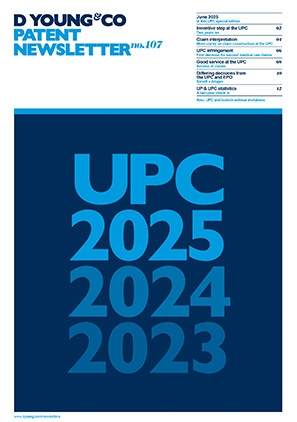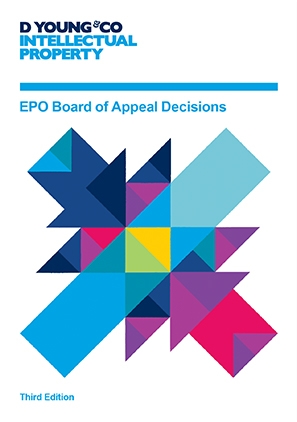Conversant v Apple: old tech, new tricks
Good user interface (UI) design for digital devices can be very valuable. This has generally been recognised by the patent system, with many major patent offices around the world allowing patents to be granted for innovative UIs. The European Patent Office (EPO), for example, even has a section of the Guidelines for Examination (Part G-II 3.7.1) dedicated solely to the patentability of user interfaces in Europe.
So, what makes a UI new and inventive? After all, many of the core ideas about user interfaces have been around for decades. Of course, a smartphone released in the last year or two is likely to have a far more sophisticated UI than that of a mobile phone from the early 2000s. But how much of this sophistication is a result of other technology (such as faster processing times, higher resolution displays and better graphics) and how much of it is down to technical improvements to the UI itself? Are old ideas simply being dressed up and reused? And how is this relevant from a patent perspective?
This case from the UK High Court (Conversant Wireless Licensing SARL v (1) Apple Retail UK Ltd & (2) Apple Distribution International & (3) Apple Inc. [2019] EWHC 3266 (Pat)) demonstrates the similarity (at least from a patent perspective) between UIs of seemingly very different products from different eras. It also helps highlight the potential opportunities and threats to holders of UI patents.
The patent concerned was GB 2365712 and was owned by Conversant. Conversant alleged the patent was infringed by the UI of various models of Apple’s iPhone. On the other hand, Apple alleged the patent was not valid based on various grounds including obviousness.
Claim 1 as granted was amended by Conversant in advance of the hearing and read: “1. A smart phone comprising a display screen, the smart phone being configured to display on the screen a main hierarchical menu system, wherein the smart phone is configured to display, in addition to the main hierarchical menu system, application summary windows for each of several different applications, in which each summary window serves as a summary of a particular application by virtue of displaying a limited list of (i) several commonly used functions offered within that particular application and/or (ii) stored data commonly accessed by that particular application, wherein the smart phone is configured to, for a given application: display, in a summary window for the given application, both a limited list of several commonly used functions offered within the given application and stored data commonly accessed by the given application; display the said commonly used functions offered within the given application without opening the given application; display the said stored data commonly accessed by the given application without opening the given application; and open the given application when an item of the said displayed commonly used functions or the said displayed stored data is selected.”
The claimed invention is exemplified in figures 1 and 3 of the patent:
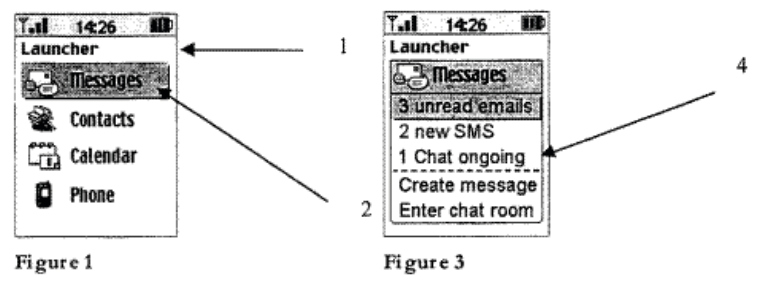
In figure 1, different applications (such as “Messages”, “Contacts”) are selectable from a main hierarchical menu system. In Figure 3, an application summary window is displayed for the application “Messages”. The application summary window displays both a list of several commonly used functions offered within the application (“Create message” and “Enter chat room”) and stored data commonly accessed by the application (“3 unread mails”, “2 new SMS” and “1 Chat ongoing”). These are displayed without opening the “Messages” application. However, “Messages” is opened if one of the commonly used functions or stored data is selected. As summarised by the judge in paragraph 74 of the decision, this arrangement “saves the user from navigating to the required application, opening it up, and then navigating within that application to enable the data of interest to be seen or a function of interest to be activated”.
The UI of figures 1 and 3 looks dated by today’s standards, reflecting the very early priority date of the patent (28 July 2000). The decision recognises the Nokia 3310 with its small, black and white screen as a popular mobile phone at around this date and the UI of figures 1 and 3 is said to be similar to that found on mobile phones such as this. The judge construed claim 1 sufficiently broadly, however, to determine that, should claim 1 be valid, the patent would be infringed by Apple.
One of the screenshots of an Apple iPhone (understood to be the iPhone X first released in late 2017) used in the case is shown:
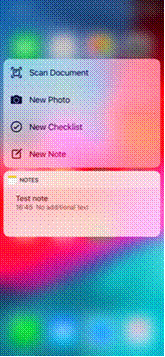
Different applications are selectable using icons (these are blurred in the background). The judge concluded that a main hierarchical menu system can include selectable “pictograms” and that the iPhone’s icons are examples of such pictograms. An application summary window (in the form of the two “widgets” seen in the foreground) is displayed for the application “Notes”. The application summary window displays both a list of several commonly used functions offered within the application (such as “Scan Document” and “New Photo”) and stored data commonly accessed by the application (in this case, a recent text note). These are displayed without opening the “Notes” application. However, “Notes” is opened if one of the commonly used functions or stored data is selected.
Thus, although the iPhone was released the best part of two decades after the priority date of the patent, it was determined to infringe claim 1 (should claim 1 be valid).
It seems that, despite the evident improved sophistication of the newer iPhone UI compared to the older UI described in the patent, the core technical features of the UI which enable the user to more quickly and easily navigate to desired functions or data of an application remained the same. Furthermore, these are covered by claim 1. In effect, the apparent improved sophistication was arguably not down to the UI itself but due to other factors such as improvements in processing time, display resolution and graphics (not to mention colour screens) in the years following the patent’s priority date.
This is potentially very good news for UI patent holders, showing potential longevity in the value of protection afford by UI patents which far exceeds that of many other digital technologies (which are typically obsolete after only a few years).
A word of warning, however. The potential longevity of good UI design may also be problematic to the patent holder. This turned out to be the case here, with claim 1 being found to lack an inventive step in view of IBM / Bell South’s “Simon” cellular phone of 1994 (together with common general knowledge). The judge considered this to be an early attempt at a smartphone. Figures from the manual of “Simon” used in the case are shown below:
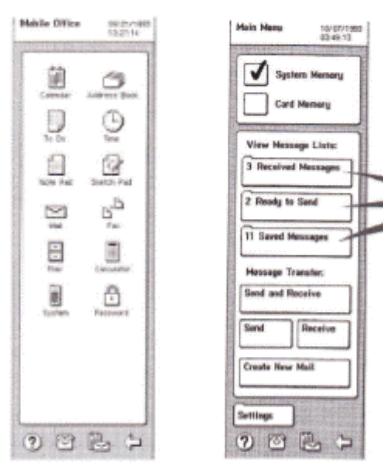
Different applications are selectable using icons of a main hierarchical menu system (similar to the iPhone). The screen shot shown above right relates to the previously opened “Mail” application and shows an application summary window. The application summary window displays both a list of several commonly used functions offered within the application (including “Send and Receive” and “Create New Mail”) and stored data commonly accessed by the application (such as “3 Received Messages” and “2 Ready to Send”).
The judge accepted that claim 1 was novel over “Simon” because this screen shot is only shown after the application “Mail” has already been opened (and claim 1 requires the functions and stored data to be displayed without opening the given application). However, the judge concluded that the concept of “notifications” for presenting information to a user without opening an application were common general knowledge at the priority date of the patent and that combining this concept with “Simon” to allow the functions and stored data to be shown without opening “Mail” would have been obvious to the skilled person.
Thus, the patent with the very early priority date was found to be invalid in view of an even earlier disclosure.
It seems that, despite the obvious differences between the 1994 IBM Simon and today’s iPhone models (a quick internet image search is recommended here!), there are more similarities between these products than one might think.
So where does it leave us? First, it helps us appreciate the work of UI engineers of the past, some of whose innovations still seem core to the functionality of today’s modern devices. Second, it highlights the value of UI patents whose potential longevity is rare in the fast moving tech industry. Third, it reminds is not to take anything as given. It’s perfectly possible for a patent nearing it’s expiry date to cover one of the world’s most popular modern products. But it’s also possible there may be even earlier disclosures out there which could serve as a lifeline for a potential infringer.
As always, if you think you may want to assert a patent against a third party or are worried about patent invalidity or infringement action potentially being brought against you by a third party, please contact your usual D Young & Co advisor.
Case details at a glance
Jurisdiction: England & Wales
Decision level: High Court (Patents Court)
Parties: CONVERSANT WIRELESS LICENSING S.à.r.l (claimant) and (1) APPLE RETAIL UK LIMITED (2) APPLE DISTRIBUTION INTERNATIONAL (3) APPLE INC. (defendants)
Date: 29 November 2019
Citation: [2019] EWHC 3266 (Pat)
